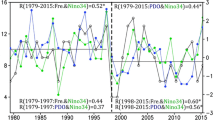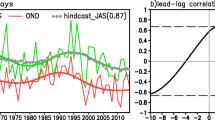Abstract
Based on an analysis of 51-year (1965–2015) data, the influence of El Niño-Southern Oscillation (ENSO) events on tropical cyclone (TC) activity is examined over the western North Pacific (WNP). The total number of TCs formed in the entire WNP reduces by about 3.4 TCs per year in La Niña years, whereas TCs have an equivalent genesis number between El Niño years and climatology. During El Niño years, the frequency of TC formation increases remarkably in the southeast quadrant (140°E–180°, 0°–17°N) and decreases in the northwest quadrant (120°–140°E, 17°–30°N). During La Niña years, TCs tend to form in the northwest and southwest quadrants (120°-140°E, 0°–17°N) quadrants. TCs tend to become long-lived in the peak season (from July to September) of El Niño years and during strong El Niño events. TC genesis shows a southeastward positive shift in terms of lifetime and intensity during El Niño years, thus more super TCs (winds ≥ 58.64ms−1) are formed in the southeast quadrant. Further analysis using the genesis potential index (GPI) indicates that the interannual variations in the TC genesis and track are significantly influenced by a combination of large-scale dynamic and thermodynamic conditions.
Similar content being viewed by others
References
Bister, M., and Emanuel, K. A., 1998. Dissipative heating and hurricane intensity. Meteorology and Atmospheric Physics, 52: 233–240.
Bister, M., and Emanuel, K. A., 2002a. Low frequency variability of tropical cyclone potential intensity. 1. Interannual to interdecadal variability. Journal of Geophysical Research, 107 (D24): 4801, DOI: https://doi.org/10.1029/2001JD000776.
Bister, M., and Emanuel, K. A., 2002b. Low frequency variability of tropical cyclone potential intensity. 2. Climatology for 1982–1995. Journal of Geophysical Research, 107 (D22): 4621, DOI: https://doi.org/10.1029/2001JD000780.
Camargo, S. J., and Sobel, A. H., 2005. Western North Pacific tropical cyclone intensity and ENSO. Journal of Climate, 18: 2996–3006, DOI: https://doi.org/10.1175/JCLI3457.1.
Camargo, S. J., Emanuel, K. A., and Sobel, A. H., 2007. Use of a genesis potential index to diagnose ENSO effects on tropical cyclone genesis. Journal of Climate, 20: 4819–4834.
Chan, J. C. L., 1985. Tropical cyclone activity in the northwest Pacific in relation to the El Niño/Southern Oscillation phenomenon. Monthly Weather Revivew, 113: 599–606.
Chan, J. C. L., 2000. Tropical cyclone activity over the western North Pacific associated with El Niño and La Niña events. Journal of Climate, 13: 2960–2972.
Chan, J. C. L., 2008. Decadal variations of intense typhoon occurrence in the western North Pacific. Proceedings of the Royal Society A: Mathematical, Physical and Engineering Sciences, 464: 249–272.
Chen, T.-C., Weng, S. P., Yamazaki, N., and Kiehne, S., 1998. Interannual variation in the tropical cyclone formation over the western North Pacific. Monthly Weather Revivew, 126: 1080–1090.
Chu, P. S., 2004. ENSO and tropical cyclone activity. In: Hurricanes and Typhoons: Past, Present, and Potential. Murnane, R. J., and Liu, K. B., eds., Columbia University Press, New York, 297–332.
Dong, K., 1988. El Niño and tropical cyclone frequency in the Australian region and the northwest Pacific. Australian Meteorological Magazine, 36: 219–225.
Du, Y., Yang, L., and Xie, S.-P., 2011. Tropical Indian Ocean influence on northwest Pacific tropical cyclones in summer following strong El Niño. Journal of Climate, 24: 315–322.
Emanuel, K. A., 1988. The maximum intensity of hurricanes. Journal of Atmospheric Sciences, 45: 1143–1155.
Emanuel, K. A., 2001. The contribution of tropical cyclones to the oceans’ meridional heat transport. Journal of Geophysical Research, 106: 14771–14782.
Emanuel, K. A., 2005. Increasing destructiveness of tropical cyclones over the past 30 years. Nature, 436 (7051): 686–688.
Emanuel, K. A., and Nolan, D. S., 2004. Tropical cyclone activity and global climate (Reprints). 26th Conference on Hurricane and Tropical Meteorology. American Meteorological Society, Miami, 240–241.
Gray, W. M., 1968. Global view of the origin of tropical disturbances and storms. Monthly Weather Review, 96: 669–700.
Gray, W. M., 1979. Hurricanes: Their formation, structure and likely role in the tropical circulation. In: Meteorology over the Tropical Oceans. Shaw, D. B., ed., Royal Meteorological Society, Bracknell, 155–218.
Gray, W. M., 1984. Atlantic seasonal hurricane frequency. Part II: Forecasting its variability. Monthly Weather Revivew, 112: 1669–1683.
Kalnay, E., Kanamitsu, M., Kistler, R., Collins, W. D., Deaven, D. G., Gandin, L. S., Iredell, M., Saha, S., White, G. J., Woollen, J. S., Zhu, Y., Chelliah, M., Ebisuzaki, W., Higgins, W. J., Janowiak, J. E., Mo, K. C., Ropelewski, C. F., Wang, J., Leetmaa, A., Reynolds, R. W., Jenne, R. L., and Joseph, D., 1996. The NCEP/NCAR 40-year reanalysis project. Bulletin of the American Meteorological Society, 77 (3): 437–471.
Kim, H.-M., Webster, P. J., and Curry, J. A., 2011. Modulation of North Pacific tropical cyclone activity by three phases of ENSO. Journal of Climate, 24: 1839–1849.
Krishnamurthy, L., Vecchi, G., Msadek, R., Murakami, H., Wittenberg, A., and Zeng, F., 2016. Impact of strong ENSO on regional tropical cyclone activity in a high-resolution climate model in the North Pacific and North Atlantic Oceans. Journal of Climate, 29: 2375–2394.
Lander, M. A., 1994. An exploratory analysis of the relationship between tropical storm formation in the western North Pacific and ENSO. Monthly Weather Revivew, 122: 636–651.
Li, C., 1988. Actions of typhoon over the western Pacific (including the South China Sea) and El Niño. Advances in Atmospheric Sciences, 5: 107–115.
Liu, K., and Chan, J., 2013. Inactive period of western North Pacific tropical cyclone activity in 1998–2011. Journal of Climate, 26: 2614–2630.
Liu, Y., and Chen, G., 2017. Intensified influence of the ENSO Modoki on boreal summer tropical cyclone genesis over the western North Pacific since the early 1990s. International Journal of Climatology, 38: e1258–e1265, DOI: https://doi.org/10.1002/joc.5347.
Matsuura, T., Yumoto, M., and Iizuka, S., 2003. A mechanism of interdecadal variability of tropical cyclone activity over the western North Pacific. Climate Dynamics, 21: 105–117.
Patricola, C. M., Camargo, S. J., Klotzbach, P. J., Saravanan, R., and Chang, P., 2017. The influence of ENSO flavors on western North Pacific tropical cyclone activity. Journal of Climate, 31 (14): 5395–5416, DOI: https://doi.org/10.1175/JCLI-D-17-0678.1.
Ramage, C. S., and Hori, A. M., 1981. Meteorological aspects of El Niño. Monthly Weather Revivew, 109: 1827–1835.
Smith, T. M., Reynolds, R. W., Peterson, T. C., and Lawrimore, J., 2008. Improvements to NOAA’s historical merged land-ocean surface temperature analysis (1880–2006). Journal of Climate, 21: 2283–2296.
Wang, B., and Chan, J. C. L., 2002. How strong ENSO events affect tropical storm activity over the western North Pacific. Journal of Climate, 15: 1643–1658.
Wang, C., Li, C., Mu, M., and Duan, W., 2013. Seasonal modulations of different impacts of two types of ENSO events on tropical cyclone activity in the western North Pacific. Climate Dynamics, 40 (11–12): 2887–2902.
Wang, L., and Pan, X., 2012. Diagnosis of seasonal variations of tropical cyclogenesis over the South China Sea using a genesis potential index. Journal of Ocean University of China, 11 (3): 267–278.
Wu, G., and Lau, N.-C., 1992. A GCM simulation of the relationship between tropical-storm formation and ENSO. Monthly Weather Revivew, 120: 958–977.
Yeh, S., Kang, S. K., Kirtman, B., Kim, J., Kwon, M. H., and Kim, C. H., 2010. Decadal change in relationship between western North Pacific tropical cyclone frequency and the tropical Pacific SST. Meteorology and Atmospheric Physics, 106: 179–189.
Yu, J., Chen, C., Li, T., Zhao, X., Xue, H., and Sun, Q., 2016a. Contribution of major SSTA modes to the climate variability of tropical cyclone genesis frequency over the western North Pacific. Quarterly Journal of the Royal Meteorological Society, 142 (695): 1171–1181.
Yu, J., Li, T., Tan, Z.-M., and Zhu, Z., 2016b. Effects of tropical North Atlantic SST on tropical cyclone genesis in the western North Pacific. Climate Dynamics, 46: 865, https://doi.org/10.1007/s00382-015-2618-x.
Acknowledgements
This work was supported by grants from the National Natural Science Foundation of China (Nos. 41621064 and 41606003). The best track data are downloaded from Joint Typhoon Warning Center (https://metoc.ndbc.noaa.gov/JTWC/), the reanalysis data set are taken from the U.S. National Centers for Environmental Predication/National Center for Atmospheric Research (http://www.cpc.ncep.noaa.gov/). We thank Dr. Kerry Emanuel for providing the code of calculating TC maximum potential intensity.
Author information
Authors and Affiliations
Corresponding author
Rights and permissions
About this article
Cite this article
Liu, Z., Chen, X., Sun, C. et al. Influence of ENSO Events on Tropical Cyclone Activity over the Western North Pacific. J. Ocean Univ. China 18, 784–794 (2019). https://doi.org/10.1007/s11802-019-3923-5
Received:
Revised:
Accepted:
Published:
Issue Date:
DOI: https://doi.org/10.1007/s11802-019-3923-5




